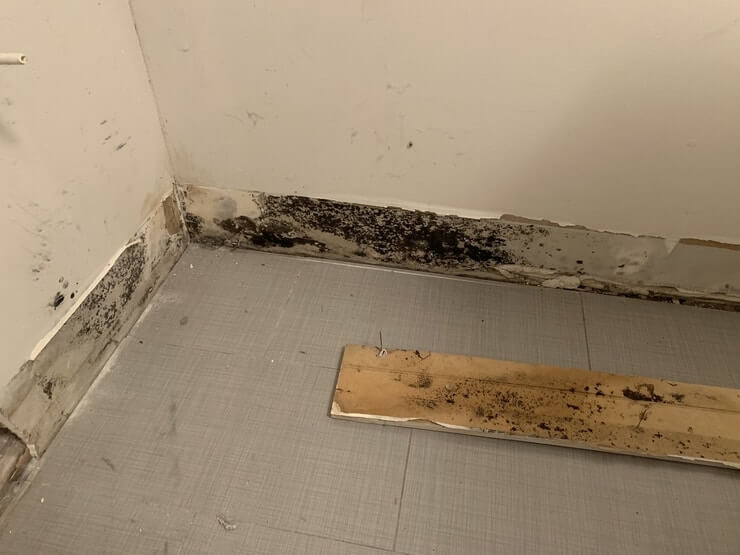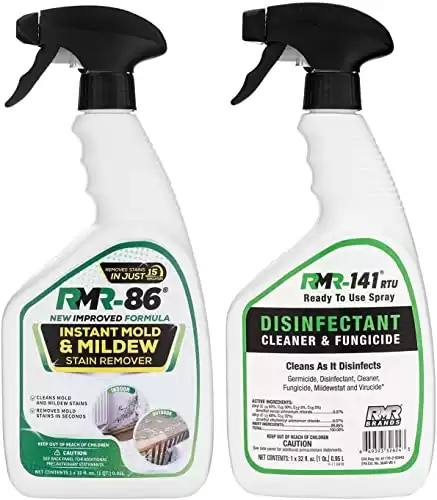Mold is both a nuisance and a health concern. Yet, while many of us check our bathroom ceilings and walls for this disgusting fungi, our baseboards often go unchecked.
Mold can affect baseboards just as badly as any other part of your home. All the water and high moisture levels associated with your bathroom can create a breeding ground for mold. Mold can be a serious health concern that you shouldn’t take lightly. There are many methods proven to prevent mold on baseboards.
There are many different species of mold from blue, black, green, and yellow, and there are almost as many ways to get rid of them. Ultimately you will want to prevent mold from ever happening in the first place.
Don’t hesitate when it comes to dealing with mold. The health of you or your family could be at risk. Learn all that you can and take action.

What Causes Mold on Baseboard?
Mold requires moisture to grow and thrive.
Of all the places in your home, it’s the bathroom that most commonly develops a mold problem.
Mold on your bathroom baseboards could have many causes.
- High moisture levels in your bathroom brought on by the weather or heavy shower usage can contribute to mold growth.
- A leaking pipe can create mold that eats at your walls and baseboards from the inside out.
- Other leaks in your roof and window frames can trickle down onto your baseboards.
- Lastly, extreme weather events like heavy rain, a hurricane, or flood can also cause your baseboards to become moldy and ruined.
Is Mold on Baseboard Dangerous?
Mold is usually not deadly, but it can cause some health concerns.
Mold can cause you to become sick, and if you come into contact with mold, it will irritate your eyes, nose, skin, throat, and lungs.
People with allergies or asthma are often more sensitive to the adverse effects of mold.
Unless the mold infestation on your baseboards is extreme, it will usually not affect you unless you bend over, lay on the floor, or are removing these baseboards.
How to Tell if Mold Is Growing On Your Baseboards
Once you can see mold growing on your baseboards, preventing it is out of the question.
It’s best to catch mold as it first starts growing, making it easier to get rid of and saves your baseboards.
One good way to detect mold is through your senses.
Mold carries a musty or earthy odor that you will smell before it ever shows up in your bathroom.
The feeling of eye or nose irritation along with a sense of sickness is another common sign your bathroom has mold.
If your baseboards appear wet or damp even though no one has showered or used the bathtub is another common indicator that there is mold growing beneath the surface.
How to Prevent Mold on Baseboards in the Bathroom
Fixing Leaks
Leaks are a common cause of mold, so fixing any leaks in your bathroom as soon as possible can prevent a mold infestation.
When a leak first occurs, it can be nearly impossible to know it’s there.
The only way to know for sure is to inspect your plumbing every three months or so.
Fixing leaks when they first begin will save you from mold and water damage that can come with a heavy repair bill.
Controlling Your Bathrooms Moisture
Your bathroom’s moisture levels play a big part in giving mold an environment in which it can develop.
So by controlling moisture levels in your bathroom, you will make it harder for mold to thrive.
Some of the ways to control moisture in your bathroom include using a dehumidifier, properly using a fan, or creating ventilation by opening a window.
Keeping Your Baseboards Dry
A direct method is to keep your baseboards as dry as possible.
You can dry them with a towel after each shower or bath and dry up any spills or splashes as soon as possible.
While keeping your baseboards dry can help prevent mold from growing on the outside, this will not stop mold from developing on the inside if you have a water leak.
Maintenance
You can prevent mold from developing on your baseboards or anywhere in your bathroom by doing regular maintenance.
I do not mean maintenance on your baseboards, although cleaning them regularly can help, I am referring to maintaining systems like your plumbing and hot water heater, which can prevent a leak and prevent mold from ever happening.
Fungicidal Paint
Fungicidal paint is also known as antifungal or anti-mold paint. It contains chemicals that can inhibit mold growth or kill it off altogether.
These paints are a little more expensive than normal paint, but the possibility of preventing mold is worth the added cost.
No fungicidal paint can completely guarantee you a mold-free bathroom, as an extreme water leak or weather event will still leave you with moldy baseboards.
Regular Inspection
A very straightforward way to prevent mold on or behind your baseboards before it goes too far is to regularly inspect your baseboards.
Look for signs of mold like foul musty, or earthy odors along with a damp appearance and irritation to your nose, eyes, or lungs.
Don’t forget to check the baseboard behind your toilet. If you suspect a baseboard may be molding, remove it and check it.
How to Clean Mold From Baseboards in the Bathroom
If the mold damage is not too extensive, you can use natural or chemical cleaners to get rid of the mold.
But in some cases, the mold has spread too far, and you will have no choice but to replace your bathroom baseboards.
Natural Cleaners
There are many solutions you can create at home using water and a variety of things around your house to remove mold.
Tea tree oil, baking soda, or lemon juice mixed 50/50 with water in a spray bottle can be an effective natural homemade solution.
Another popular homemade remedy is to use undiluted vinegar to remove mold.
With the vinegar, it’s better not to mix it with water and let it sit on the mold for a few hours before cleaning it off.
Chemical Cleaner
A good chemical cleaner walks the thin line between effectively removing mold without damaging your walls or baseboards.
Bleach has commonly been used to get rid of mold, but better options are out there.
One chemical product we would recommend is RMR Complete Mold Killer & Stain Remover Bundle.
This product works quickly and does not require you to scrub the mold away, which can help prevent wall and baseboard damage.
- Kills Mold and Mildew Instantly
- Removes Stubborn Stains in Seconds
- No Scrubbing Needed
The ultimate mold prevention kit. This bundle includes 1 spray bottle of RMR-86 and 1 spray bottle of RMR-141 RTU to kill mold and mildew instantly while lifting difficult stains that are left behind.


